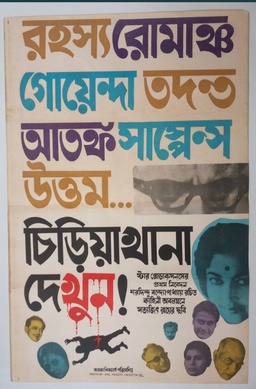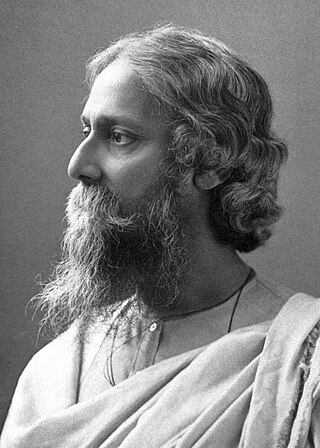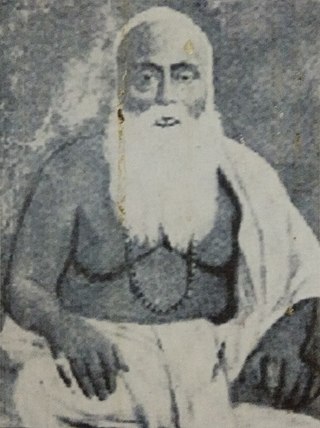Related Research Articles

Bankim Chandra Chattopadhyay was an Indian novelist, poet, essayist and journalist. He was the author of the 1882 Bengali language novel Anandamath, which is one of the landmarks of modern Bengali and Indian literature. He was the composer of Vande Mataram, written in highly Sanskritised Bengali, personifying India as a mother goddess and inspiring activists during the Indian Independence Movement. Chattopadhayay wrote fourteen novels and many serious, serio-comic, satirical, scientific and critical treatises in Bengali. He is known as Sahitya Samrat in Bengali.

Jagatdhatri or Jagaddhatri is an aspect of the Hindu goddess Durga, worshipped in the Indian state of West Bengal and other states like Odisha and Jharkhand.Maa Jagadhatri, the Goddess who is revered as the protector of the world.The Jagadhatri Puja and Mela at Bhanjpur Jagadhatri Podia is the biggest festival in Baripada,Odisha. Jagaddhatri Puja is particularly famous in Chandannagar town of Hooghly district,Krishnanagar of Nadia district and Ichhapur Nawabgunj of North 24 Parganas in West Bengal where it is celebrated as a five-day-long festival. Her worship and rituals are derived from Tantra. It is believed that her worship frees her devotees from ego and all other materialistic desires.

The Mahājanapadas were sixteen kingdoms and aristocratic republics that existed in ancient India from the sixth to fourth centuries BCE, during the second urbanisation period.
Byomkesh Bakshi is an Indian-Bengali fictional detective created by Sharadindu Bandyopadhyay. Referring to himself as a "truth-seeker" or Satyanweshi in the stories, Bakshi is known for his proficiency with observation, logical reasoning, and forensic science which he uses to solve complicated cases, usually murders, occurring in Calcutta.

Sharadindu Bandyopadhyay was an Indian Bengali-language writer. He was actively involved with Bengali cinema as well as Bollywood. The creator of the Bengali detective Byomkesh Bakshi, Sharadindu composed stories of a wide array of varieties including: novels, short stories, crime and detective stories, plays and screenplays. He wrote historical fiction like Kaler Mandira, Gourmollar, Tumi Sandhyar Megh, Tungabhadrar Teere, Chuya-Chandan, Maru O Sangha, Sadashib series and stories of the unnatural with the recurring character Baroda. Besides, he composed many songs and poems.

Chiriakhana or Chiriyakhana is a 1967 Indian Bengali-language crime thriller film, based on the story of the same name by Sharadindu Bandyopadhyay. The film is directed and co-written by Satyajit Ray, starring Uttam Kumar as Byomkesh Bakshi. The screenplay is written by Satyajit Ray. The film was once considered Ray's worst film because of its complex plot and unfaithfulness to its source material, however the flexible acting of Uttam Kumar was praised by many critics at that time. The film was remade in Hindi as a television series Byomkesh Bakshi with Rajit Kapoor aired in Doordarshan.

Kamsa was the tyrant ruler of the Vrishni kingdom, with its capital at Mathura. He is variously described in Hindu literature as either a human or an asura; The Puranas describe him as an asura, while the Harivamśa describes him as an asura reborn in the body of a man. His royal house was called Bhoja; thus, another of his names was Bhojapati. He was the cousin of Devaki, the mother of the deity Krishna; Krishna ultimately fulfilled a prophecy by slaying Kamsa.

Vatsa or Vamsa was one of the sixteen Mahajanapadas of Uttarapatha of ancient India mentioned in the Aṅguttara Nikāya.

Bengali literature denotes the body of writings in the Bengali language and which covers Old Bengali, Middle Bengali and Modern Bengali with the changes through the passage of time and dynastic patronization or non-patronization. Bengali has developed over the course of roughly 1,400 years. If the emergence of the Bengali literature supposes to date back to roughly 650 AD, the development of Bengali literature claims to be 1600 years old. The earliest extant work in Bengali literature is the Charyapada, a collection of Buddhist mystic songs in Old Bengali dating back to the 10th and 11th centuries. The timeline of Bengali literature is divided into three periods: ancient (650–1200), medieval (1200–1800) and modern. Medieval Bengali literature consists of various poetic genres, including Hindu religious scriptures, Islamic epics, Vaishnava texts, translations of Arabic, Persian and Sanskrit texts, and secular texts by Muslim poets. Novels were introduced in the mid-19th century. Nobel laureate Rabindranath Tagore is the best known figure of Bengali literature to the world. Kazi Nazrul Islam, notable for his activism and anti-British literature, was described as the Rebel Poet and is now recognised as the National poet of Bangladesh.

Narayan Sanyal was an Indian writer of modern Bengali literature as well as a civil engineer.

"Malhar" is a Hindustani classical raga. Malhar is associated with torrential rains.
Satish Chandra Mukherjee was a pioneer in establishing a system of national education in India, along with Sri Aurobindo.

Akshay Chandra Sarkar –was a poet, an editor and a literary critic of Bengali literature.
Devi Chaudhurani is a Bengali novel written by Bankim Chandra Chatterjee and published in 1884. It was later translated to English by Subodh Chunder Mitter. Following closely after Anandamath, Bankim Chandra renewed call for a resurgent India that fights against oppression of the British Empire with strength from within the common people, based on traditional Indian values of austerity, dedication and selflessness. It is another important novel in the history of Bengali and Indian literature. Since it fuelled the patriotic struggle for Indian independence from the British Empire, the novel was banned by the British. The ban was lifted later by the government of India after independence. In this novel, Bankim Chandra reinforced his belief that armed face-to-face conflict with the Royal Army is the only way to win independence.
Durgeshnandini is a Bengali historical romance novel written by Indian writer Bankim Chandra Chattopadhyay in 1865. Durgeshnandini is a story of the love triangle between Jagat Singh, a Mughal General, Tilottama, the daughter of a Bengali feudal lord and Ayesha, the daughter of a rebel Pathan leader against whom Jagat Singh was fighting. The story is set against the backdrop of Pathan-Mughal conflicts that took place in south-western region of modern-day Indian state of Paschimbanga during the reign of Akbar.

Shajarur Kanta is a 2015 Byomkesh Bakshi mystery film based on the novel of same name by Sharadindu Bandyopadhyay. The film is directed by Saibal Mitra, and produced by Pradip Churiwal and Saikat Mitra. It is the second Shajarur Kanta film adaptation in Bengali, the other being the 1974 film of same name.
Satyanweshi also spelled Satyanveshi, is a detective story written by Sharadindu Bandyopadhyay featuring the Bengali detective Byomkesh Bakshi and his friend, assistant, and narrator Ajit Bandyopadhyay. It is the first Byomkesh adventure written by Sharadindu Bandyopadhyay.
Durgo Rahasya is an adventure detective novel written in 1952 by Sharadindu Bandyopadhyay.

Gar Mandaran is a village and a gram panchayat in the Goghat II CD block in the Arambag subdivision of the Hooghly district in the state of West Bengal, India.
Dariapur is a village in the Deshapran CD block in the Contai subdivision of the Purba Medinipur district in the state of West Bengal, India.
References
- ↑ Amiya P. Sen (28 February 2001). Hindu Revivalism in Bengal, 1872–1905: Some Essays in Interpretation. OUP India. pp. 102–. ISBN 978-0-19-908770-9.
- ↑ S. K. BOSE (5 June 2015). BANKIM CHANDRA CHATTERJI. Publications Division Ministry of Information & Broadcasting. pp. 31–. ISBN 978-81-230-2269-7.
